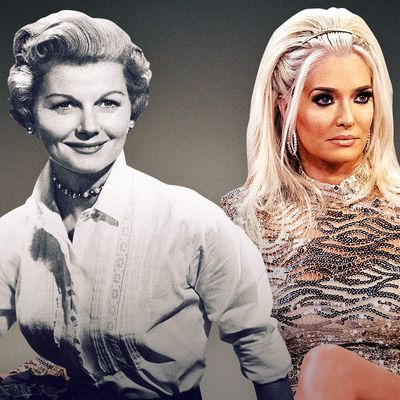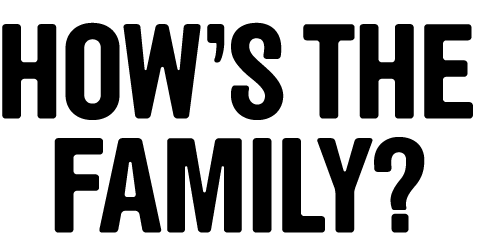
As long as there’s been TV, the family has been one of its favorite go-tos. All week long, Vulture is exploring how it’s been represented on our screens.
We tend to mark the evolution of families on TV by certain milestones: the first TV divorces, the first interracial families, and the move away from sincere, sanitized sitcoms to grittier portraits of family life. You can consider individual family roles and think about the way the TV father has changed from a benevolent, distant god to a Babybjörn-wearing stay-at-home dad. You can think about how changes in TV storytelling models have also meant changes in the kinds of family stories we see on TV — when we leapt into the world of serialized prime-time soaps in the late ’70s, we also leapt into the world of messy ongoing family drama. Perhaps most fascinating, though, is the evolution of the housewife.
For a long time — several decades, eons in TV history — if I described a woman on TV as a “housewife,” that meant a very particular, stable thing. A housewife was a woman who runs a household. She was married (“wife” is right there in the word). She probably had children. Her primary occupation was to manage the home, which might include anything from cooking to household budgeting to child care to hosting. A version of that definition of housewife goes back to the 13th century, at least. It’s family as vocation, as career, as societal role. It is selfhood as defined through the family.
That housewife has long been one of the most visible members of the TV family. She is Harriet Nelson and June Cleaver and Claire Dunphy and the mom from Home Improvement. When she’s not there, her absence is a fundamental part of the show’s premise, as in Full House or a show like Who’s the Boss, where the entire gag is that the mom works, get it! A classic housewife wears an apron, pushes a vacuum, and deftly pulls casseroles from the oven. Her more modern counterpart has a minivan, a carefully tailored plaid button-down shirt, a peanut-butter-smeared slice of bread in one hand, a soccer bag in the other. In either iteration, her expression is usually exasperated or exhausted, concerned or patient. She occasionally expresses frustration with the limits of her role, and then starts an Etsy store or teaches yoga for an episode. In dramas and melodramas, the labor and tedium of housewifery gets more play. Housewives are more likely to be cast as dissatisfied, stunted. Desperate.
As of the last decade or so though, “housewife” has had a double meaning. If the woman in question is not a housewife but rather a Housewife, the picture of her looks different. She wears a jewel-toned ball gown, and pivots to the camera while saying her signature catchphrase. She takes vacations to Dubai. She hosts themed parties and holds long grudges. She may occasionally wield a knife to apply peanut butter to a slice of bread, but it’s meant less as a portrait of how grounded she is, and more as a universally understood symbol of how grounded she wants to appear. She is Real.
The idea for the Real Housewives came out of an idea not that far removed from the original June Cleaver version: After the success of the Laguna Beach reality show which focused on teens, there was an idea that a show about wealthy, infighting mothers might be a hit. June was never one for squabbling with the neighbors, but at least initially, the family role was pretty close. The original cast members were mostly married mothers, with a single mom and an engaged women mixed in, and the idea was that we’d follow their very suburban lives as they managed their homes, took care of their kids, and — it was heavily implied — lived in comfortable luxury on their husbands’ salaries. They’d be close to a housewife of the Desperate variety, presumably, but would still bear at least some resemblance to what being a housewife implied.
From the jump, though, there was a sense that these women were not going to be wearing aprons and pulling pot roasts out of the oven. The word “real” does a lot of heavy lifting in that title: It signals the franchise’s reality genre, of course, at a moment in 2006 when reality TV was still nascent enough to need some signaling. But it’s especially working to draw a line between reality and fiction in the idea of being a housewife. If Vicki Gunvalson is what a real housewife looks like, the “fake” housewife is the one we carry as an imagined, beatific maternal housekeeper in our collective unconscious. The fake housewife is Donna Reed. The real ones are the ones with their own dance-pop alter egos, who have homes so big they contain movie theaters and bathrooms with sofas and fireplaces, and who get in spats about not being invited to Kyle Richards’s White Party.
As the franchise has grown into its own empire of reality content, spawning new series in new cities and spinoff series and stand-alone celebrities, it’s also drifted ever farther from the housewife as a figure tied to a TV family, and carved out an entirely new territory for the meaning of the word. A Housewife does not need to be married, or in a serious relationship. In fact, zero of the current cast of Real Housewives of New York are married. She does not need to have children. She is no longer conceived of in any family context at all, in fact. Even for the Housewives who are married or have children, on TV they are Housewives first and wives and mothers second. (You can tell this is true because they regularly insist they’re wives and mothers first, and they do so while sitting on velour Real Housewives reunion-special sofas and speaking to Andy Cohen about how they try to rise above their feuds with the other women.)
There’s plenty of cultural ire for the Real Housewives, and there are bountiful reasons to dislike them. They’re wealthy women, for the most part. They mine their lives and their families and their careers for notoriety. Their televised lives consist of going to events, hating each others’ guts, gossiping, and ogling each others’ assets. They are hardly feminist icons, and the complaints about them tend to focus on their inanity, their one-percenter lives, and their “fakeness.” But there’s not much Housewife criticism that focuses on wishing they’d be more like the older definition of housewife. The evolution of the TV family — away from saintly mothers and toward women as people with their own desires — drove the housewife in this direction, and there’s no stuffing her back into an apron.
When you consider the Housewife as a new branch of the original housewife definition rather than a separate island of meaning, she charts as remarkable an evolution as any other member of the TV family. The housewife follows a progression from someone inextricably defined by her relationship to her family, to a media savvy, persistently groomed, carefully self-branding woman who strives for power and selfhood among a group of peers. Freed from the necessary family-first framework, the Housewife steps out of her binary as either angel of the house or desperate housewife, and instead becomes something closer to a sister doin’ it for herself. The original housewife has a vocation defined by her relationship to her family unit. The Real Housewife, at least as she appears in the edited, carefully polished Bravo package, lives and dies by her ability to define herself. And when housewives are divested of both houses and husbands, you’re left with — finally — just a group of women. (And also Andy Cohen.)






